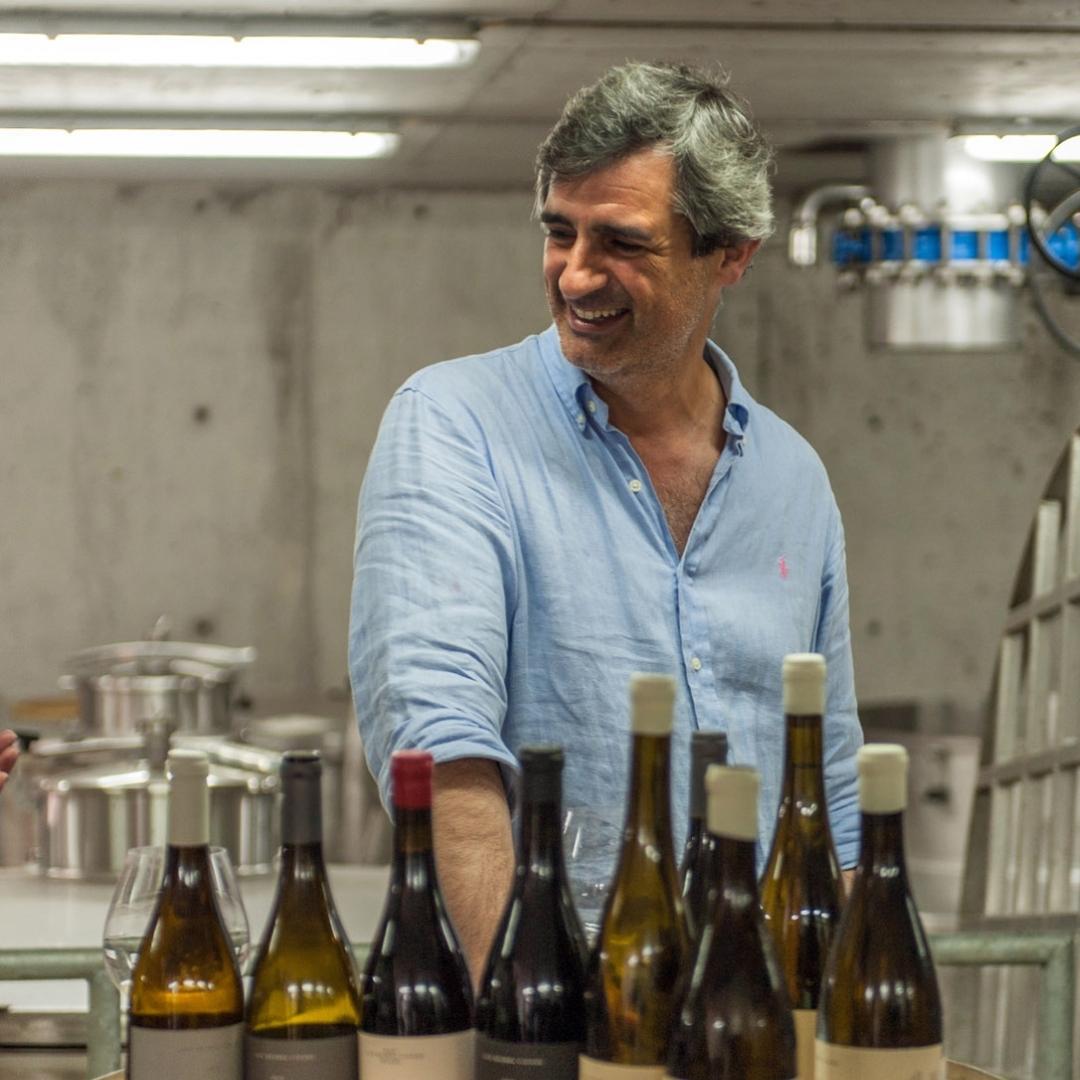
Wines from Luís Seabra
Granito Cru AlvarinhoGranito Cru Dão Branco
Indie Xisto
Mono Alfrocheiro
Mono Castelāo
Xisto Cru Branco
Xisto Cru Tinto
Xisto Ilimitado Branco
Xisto Ilimitado Tinto
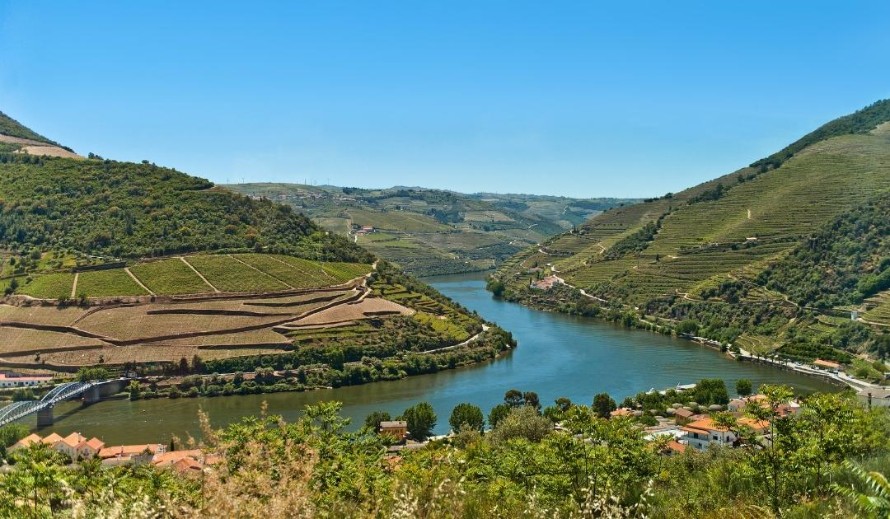 Douro, Portugal
Douro, Portugal
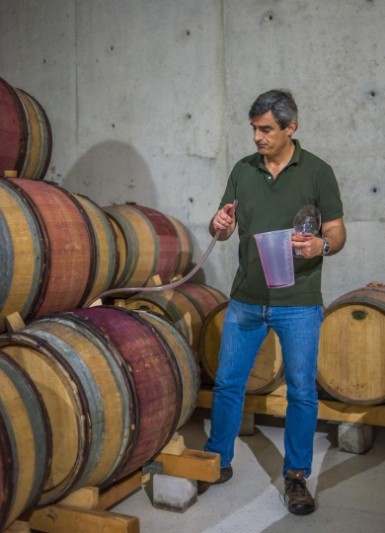 Luis at the Winery
Luis at the Winery
 Winery
Winery
 Vineyard
Vineyard
 Luis Seabra
Luis Seabra
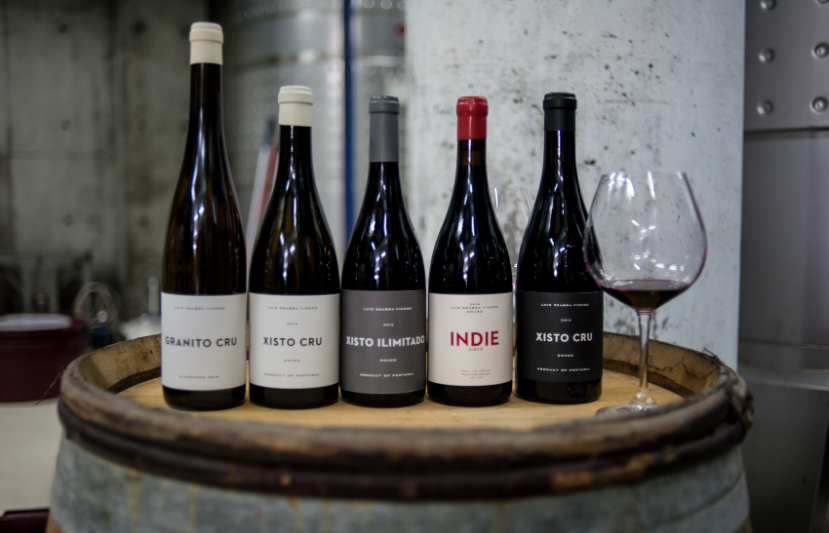 Wines
Wines
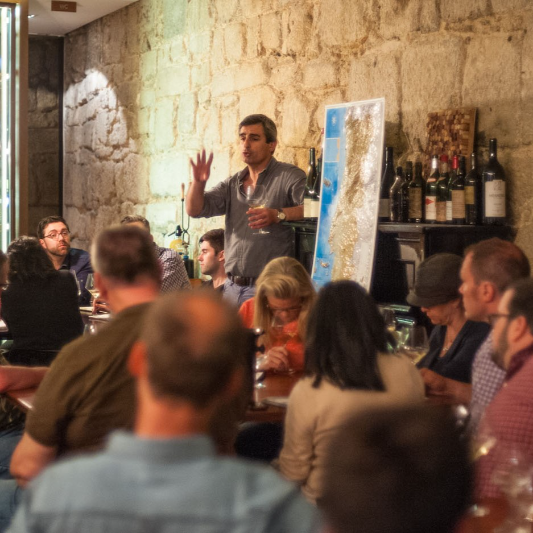 Tasting
Tasting
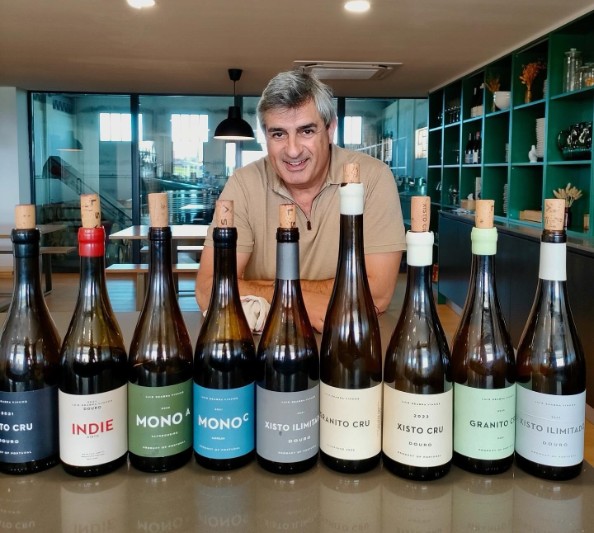
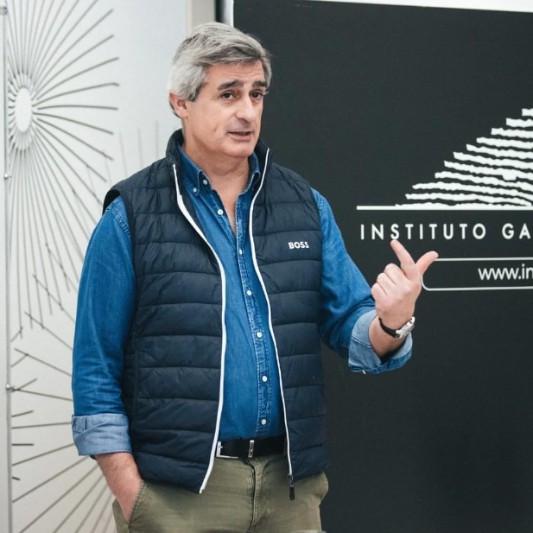
Luís Seabra
Luís Seabra Vinhos
Douro, Dão & Vinho Verde, Portugal
Download PDFFor nearly two decades, Luís Seabra has been at the center of a cultural shift in Portuguese winemaking, leading a movement of young, independent winemakers making history by reclaiming historical vineyards, grape varieties, and techniques. After a celebrated career as a soil researcher in Vinho Verde, enology instructor, and producer of world-famous still wines in Douro, Seabra finally launched his own small winery in 2013, Luís Seabra Vinhos. His work is dedicated to proving that fresh, elegant, terroir-driven still wines can be made in this region, despite centuries of byzantine traditions that favor commodity growers, overripe fruit, and massive internationally owned wineries.
Seabra’s fundamental understanding of terroir coupled with his philosophy of minimal intervention in the vineyard and winery have launched him into the international eye as a leader of the “New Portugal” renaissance. According to Eric Asimov of The New York Times, Seabra “making some of Portugal’s most compelling wines, both white and red.” As his project in Douro has grown, he has expanded his work to include special projects in neighboring regions like Vinho Verde and Dão. Regardless of where he works, at the end of the day, Luís simply wants to make wines that he enjoys drinking, wines that clearly communicate a sense of place, ideally made from old vines. For him, the ideal wines are restrained yet vibrant, balanced, and age worthy.
Luís Seabra was born into a coffee farming family in Angola and returned to Portugal in the 1970s. Although he did not grow up in a winemaking environment, his father’s family is originally from Douro, which is where Luís has made his mark as a champion of terroir-driven winemaking. He studied viticulture at the university in Vila Real, in the Alto Douro region of northern Portugal, the crossroads between Douro and Tras-os-Montes. After graduation he spent some time as a teacher, but his boundless curiosity quickly led him to work in soil research and later for one of the large cooperatives in Vinho Verde. Most famously, Luís launched a revolutionary still wine program in 2004 while working at Niepoort, upending 300 years of tradition that kept Douro entrenched in the world of fortified wines, with very few exceptions.
Luís lives upriver from Porto in rural Douro with his wife Natalia, who is also a winemaker and who plays an essential role in his operation. Known for their famous hospitality, Luís and Natalia often host large dinners with his team of interns and other winemakers; his comprehensive understanding of global wines and love of cuisine keeps him from succumbing to the myopic view that some winemakers develop in iconic regions such as Douro. Always playful and curious, Luís loves to compare his wines to another passion of his—jazz music. His broad approach has led him to become an excellent winemaking mentor as well as a sought-after consultant for other wineries.
IN THE VINEYARD
Seabra has spent his career working in Portugal’s two largest winegrowing areas, Douro and Vinho Verde. Combined, the two regions are home to nearly 100,000 hectares of vineyards, often spread out over steep hills and ancient terraces. Farming does not come easy in northern Portugal; in Douro, the heat is intense and the landscapes forbidding, while in Vinho Verde, the damp climate puts a high level of disease pressure on vineyards. In addition, the culture in these historic areas is biased against small winemakers, as most of the thousands of small-scale growers sell their fruit to large cooperatives or internationally owned wineries and need a great deal of coaxing to diverge from these traditions. Lastly, due to historical circumstances, there has been very little widespread investment in understanding the soils and microclimates of these two massive regions, meaning that an independent producer like Seabra was truly starting from a blank slate in his understanding of soils.
Compared to his neighbors, Seabra takes a “micro” approach, working with just 8 hectares total across three regions: Douro, Vinho Verde and Dao. Because of his experience working for a large cooperative in Vinho Verde, he has the unique ability to see that the vineyards desirable for uniform, commodity wines are the opposite of what he needs. Instead, he favors old—often extremely challenging! —vineyards to produce wines of character. He has developed a sixth sense around finding these remote, high-altitude vineyards, saying “You look at them and you just know that anything you do from that site is going to be great.” These demanding sites give new meaning to “off the beaten track”—a vast understatement for vineyards that require leaving your car by the side of the road and descending treacherous slopes to access!
Seabra rents vineyards from growers the way the locals always have, with a handshake and goodwill. In some—namely, all the Cru sites—he and his team farm directly. Wherever he has viticultural control, Seabra practices “common sense” agriculture, avoiding chemical treatments unless it would mean the loss of an entire vineyard to disease. It is safe to say that 95% of the time, Seabra farms organically, without the use of any chemical treatments. While working at Niepoort, he observed how the pH of still wines improved after ceasing the use of herbicides, and to this day just applies copper and sulfur in the vineyards. Moreover, the presence of some weeds and vegetation creates healthy competition for the vines, causing them to grow more slowly, thus prolonging hang time and adding more complexity to the final product. In the most disease-susceptible sites in Vinho Verde, he believes it’s important to hire a professional “task force” vineyard team that can give the close oversight needed to maintain healthy plants.
Although his goal is to eventually own all his vineyards, Seabra recognizes that this will be a multigenerational process. In the meantime, the diverse range of sites and varietals that he works with has kept him very busy—and successful—for the last decade. In Vinho Verde, his focus is on the powerful Alvarinho that put the Monção & Melgaço subzone on the map. In Dão, his white blend of Encruzado, Bical and Sercial, and monovarietal red Alfrocheiro (known as Baboso Negro in the Canary Islands), are departures from the region’s preferred grapes: Touriga Nacional and Malvasia, both of which he finds too aromatic. Lastly, in Douro, Luís vinifies over one dozen local varieties, from reds like Touriga Franca (the “backbone” of Douro), Rufete, Tinta Amarela, Tinta Roriz, and interloper Castelão—but in any given red blend, he notes that you can find tiny splashes of other varieties due to the regional tendency to plant field-blend style. For the Douro whites, Luís relies on Rabigato, Codega, Viosinho, and Gouveio (Godello).
IN THE CELLAR
Seabra’s winemaking philosophy boils down to his desire, at the end of the day, “to make wines [he] wants to drink.” As one of the “New Portugal” winemakers most prominently in the international spotlight, it’s clear that his preferred style also resonates with the top minds in the fine wine trade and press. His learnings over the years have helped him design a new winery, currently under construction, which will allow him to grow and also make his wines in oxygen-friendly concrete tanks, allowing him to mature more wines in larger format barrels down the road.
Currently, for white wines, Luís prefers to harvest all the varieties at once, so the spectrum of flavors and acidity are balanced. His approach to these blends is reminiscent of the intuitive seasoning and pairing strategies he employs as a skilled home cook; the final product is far greater than the sum of its parts. All the white wines are fermented spontaneously and with little to no temperature control and can take three or four months to complete. All the white wines except the Ilimitado are fermented in barrel, and all the whites complete full malolactic for better stability. In white wines, he prefers minerality and texture to flashy primary fruit. Although the wines may initially come across as austere, they are made to age and evolve in the bottle.
Seabra prefers that his red wines fall between the red and blue spectrum on the palate, avoiding rich, concentrated black fruit flavors and high alcohol. All the reds except Ilimitado are fermented in wooden vat or barrel, with minimal temperature control. Most of the red wines are fermented whole cluster and experience extended macerations of up to two months, allowing the tannin to refine. Seabra’s approach to barrel aging reds depends on the presence of tannin in the wine; the hard tannins of the foot-trodden Indie Xisto, for example, requires smaller barrels to maximize oxygen exposure, while the softer tannin of Mono A can develop well in a large tonneaux.
No matter if the wine is red or white, Seabra sticks firmly to his winemaking fundamentals, all of which can be summed up as balanced and minimal. He never uses new oak and knows that with high tannin wines, the barrels need to be smaller in order to introduce more oxygen, and that malolactic in barrel leads to more stability. Because of these steps, his wines are naturally stable and don’t require any additions; only light fining and filtering is done before bottling for most of the wines, as Luís believes that cloudy wines are too “noisy” and less precise. Lastly, his understanding of the balance between tannin and acidity ensures that his wines will always have freshness and longevity, even in warm vintages.
APPELLATIONS & WINE
Luís Seabra Vinhos is a small yet ambitious operation, with several labels contained within the winery brand. Seabra started out with the “Cru” series; cru means “raw,” and these wines all come from singular terroirs, whether in Douro, Dao, or Vinho Verde. He also produces the “Ilimitado” red and white; these are fashioned after the Burgundian villages system, meant to represent certain districts within the larger Douro. Lastly, his “Mono” series is dedicated to monovarietal expressions that always offer something unexpected.
In Vinho Verde, Luís produces just one wine, the Granito Cru Alvarinho, which is among the most in-demand of his entire line. The vineyards are located in the Monção & Melgaço subzone, where granite soils add intensity and complexity to the stone fruit and bright acid of Alvarinho. The long, slow fermentation and aging in 1,000L oval barrels and full malolactic make this a wine destined to age for decades and represents a new face of Alvarinho in Portugal.
In Dão, Luís was inspired by his tasting memories of white wines from the 1960s, which he describes as not exuberant, but wines of austerity and complexity that were made in a way to allow them to show up over time. His blend of Encruzado, Bical and Sercial (Granito Cru Dão Branco) is an expression of Dão’s granite and quartz soils with a slightly reductive profile; as Luís says, “Those are my memories of the Dão. It was a privilege to taste those wines.” This wine is fermented slowly in 500L barrels with no racking and aged for one year in barrel with another 6 months in stainless to settle prior to bottling. In Dão, Luís also makes the “ethereal” Mono A Alfrocheiro, which comes from a vineyard rented from one of his consulting clients. The vineyard is planted to many local varieties, but Seabra only purchases the Alfrocheiro, which ferments 40% whole cluster in wooden vats. It is racked to stainless before being aged in a single 3,000L used tonneaux made from Eastern European oak, just like those used in Piedmont. The large size allows for the slow development of the wine and the preservation of its lighter tannins.
In Douro, Luís is best known for his Xisto Ilimitado Branco and Tinto and Xisto Cru Branco and Tinto. The Ilimitado wines are both field blends from Cima Corgo, near the village of Pinhao; the white is from mica schist terroirs, and the red from yellow, and both age for one year in neutral barrel. Xisto Cru Branco and Tinto are both from centenarian vineyards with very distinct personalities. In the Tinto, the wine comes from two high elevation sites on opposite sides of the river; the fruit is harvested in mid-September and co-fermented in wood, with a long élevage in small (225L) barrels to encourage oxygen to soften the “grumpy” tannins. The Branco comes from the highest and latest-ripening vineyard in Douro and is fermented in Burgundy barrels reserved exclusively for this wine. Always low alcohol, zingy and complex, this is a gem in the world of white wines! Indie Xisto, which is based in a local clone of Tinta Roriz (but contains over 10 varieties!) and comes from an area known for fortified muscatel. This region’s hard blue slate produces what Luís considers an “ideal” Douro red, with firm tannin, blue fruit, and spice—almost like “a riper Cabernet Franc.” For now, the wine is made using ancient stone lagars and plenty of foot-treading before fermentation and aging in 500L barrels.
Some of Seabra’s smaller Douro projects are less traditional, but still fascinating, and show his playful understanding of what is possible in this region. Véu de Xisto Branco (Veil of Schist) is a white blend of Rabigato, Gouveio and Códega that is made in just two 500L barrels originally from Jura. The wine rests on the lees with no batonnage for three years. Notably, this wine is permitted to develop a layer of Flor, like Sherry or Jura wines, before resting in stainless tanks for another two years before bottling. Lastly, Seabra has recently debuted the Mono C Castelão, a bottling of southern Portugal’s most widely planted grape found in the unlikely terraces of Douro! With its lower tannin and color, an expert hand is needed to pick at the right moment and create a wine that has both roundness and fresh tannin; Luís calls this wine a “rugby player,” and its easygoing nature still bears that unmistakable Seabra energy.
Let’s stay in touch
“We’ll keep you in the loop about future events, winemaker tastings, recipes, new releases, travel guides and other occasional updates.”
